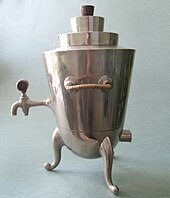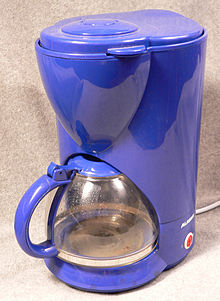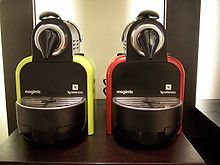coffee machine
A coffee maker is a device for brewing coffee . This is created by hot extraction and filtration of ground coffee beans with water as the extraction agent.
Forms common today are the filter coffee machine, the fully automatic coffee machine , the espresso machine and the portion coffee machine . The coffee filters used are paper filters, metal sieves or coffee pods .
history

Semi-automatic coffee machines have been around for about 200 years. Very different methods of preparing coffee have been developed over and over again, whereby the coffee machines were initially operated with alcohol and only electrically operated since the first decade of the 20th century. However, these devices were initially unaffordable for the general public because of their price. In the 1930s, for example, a silver-plated electric coffee machine (mostly in the form of a percolator, see below ) cost a worker about half a year’s salary.
It was only after the Second World War that there were significant technical improvements and coffee machines became more widespread. The 1954 patented Wigomat by Gottlob Widmann was the first modern filter coffee machine. This type spread very quickly, starting from Germany, in Western Europe and North America and replaced the previously common percolators and vacuum generators. The main advantage was the lower brewing temperature, which was closer to the ideal of 92 to 94 ° C. The coffee machine made its breakthrough in the mass market in the 1970s. The system that is still used today, with which the water is heated and passed through the coffee filter filled with ground coffee, into a jug on a hotplate, prevailed at that time.
Portion coffee machines with pad and capsule systems have been advertised very aggressively since the 2000s . Compared to classic coffee from portafilter and filter machines, the low price of the machine is offset by higher follow-up costs per coffee ( lock-in effect ). The main advantage of these machines is the consistently reproducible quality of the finished coffee with little effort due to the precisely measured amount of powder in the pods or capsules.
Modes of operation
Filter coffee machine
The functional principle of a filter coffee machine is often based on a bubble pump . The water runs through a non- return valve built into the supply hose into a heatable pipe in the heating element of the hotplate. The incoming cold water heats up until steam bubbles form, creating pressure that closes the check valve. The hot water rises up through a pipe into another (usually swiveling) pipe that ends above the filter and flows onto the coffee powder in the filter. The pressure in the heating pipe drops until the non-return valve opens and new cold water runs into the heating pipe. This process is repeated periodically. This and the evaporation of residual water creates the typical rattle. The finished " filter coffee " collects in the jug under the filter and above the heating plate .
When the cold water in the water tank is used up, the temperature of the heating pipe rises to around 130 to 150 ° C; At this temperature, a temperature switch either switches off the pipe heating completely or regulates the temperature of the plate in coffee machines with a warming function for the jug (where the heating pipe is directly under the warming plate) by cyclically switching it on and off until the machine is switched off manually. In addition, an appropriate temperature fuse at around 180 ° C ensures that no overheating can occur in the event of a defect.
Machines that work with a direct brewing system work a little differently . The water is not heated step by step in a pipe, but the entire water supply is brought to a bubbly boil in a water tank and then runs over the ground coffee, controlled by a valve. This process is much closer to traditional manual scalding. As a rule, a high and constant brewing temperature of over 90 ° C is achieved. Machines of this type are offered by several manufacturers today, including AEG , Krups , Melitta , Philips , Severin .
Coffee machines need more electrical energy to heat the water than kettles , as a certain amount of energy always escapes with the steam. In addition, there is the warming performance after the coffee has been made.
Espresso pot / moka
A widely used method of preparing coffee in Italy, in which water is heated in a moka pot on the stove and the hot water is forced through the ground coffee using excess steam.
Percolator
The percolation is still a commonly used method for preparing coffee today. The word derive from the Latin verb percolare "percolation, leaked" from.

The coffee percolator was invented by Benjamin Thompson between 1810 and 1814. The invention of the modern coffee percolator with an inner cylinder is attributed to the Parisian tinsmith Laurens. In 1819 he developed the first coffee pot in which the water was heated on the stove and then rose through an inner cylinder. This principle was subsequently adopted and changed many times. There were also experiments with closed systems, so-called vapor pressure percolators.
In America, where the filter method is not so well known, coffee is still more often prepared according to the percolation principle, as is the case in England and the Netherlands. In Germany, the percolator has almost been forgotten. Some large coffee machines still work according to this principle. The devices for domestic use were mostly made of metal, simple versions made of aluminum, others made of chrome-plated or silver-plated brass. Since the coffee easily took on the metal taste, some manufacturers switched to making the devices at least partially from glass or entirely from porcelain. Porcelain electric coffee makers were very common in the United States. In Germany, Rosenthal manufactured coffee machines in the 1930s. The devices from the Neuerer porcelain factory known as "Aromators" are particularly widespread.
The operating principle of the percolator differs significantly from the filter jug. A simple percolator is a jug with a metal tube inside. An aluminum container that is used as a coffee filter is attached to the upper third of this cylinder. In the lid of the jug there is usually a small glass dome through which you can watch the brewing process. When the water is heated, it is pushed up through the pipe. Here it drips down from above onto the grist and then mixes again with the water in the jug. This circulating process repeats itself and is only interrupted when the coffee has the desired strength.
A distinction must be made between these circulating percolators and pump percolators, in which the water only drips once over the grist and is then collected in a separate container. These percolators therefore have, in addition to a "water container", another container for the finished coffee, which is usually drained via a small outlet tap. The espresso pot is also one of the pump percolators.
Examples of common circulating percolators made in Germany are: WMF (replica of the American company Landers / Universal from 1880 to 1930, both heated with alcohol and electrically); Graetzor (1930 to 1966); Linnschiff , Feldhaus (simple percolators from the 1950s), Rowenta (around 1920 to 1962) and many more.
Examples of well-known pump percolators are: AEG , (Germany, 1930s - design by Peter Behrens ); Moccadur ( GDR , 1950s; inventor Otto Bengtson ) and Therma (Switzerland, 1960s).
Percolators have recently been made from Jena glass again . These new percolators are equally suitable for gas , ceramic and electric stoves.
Vacuum maker
A further development of the percolators are the vacuum generators, which have been in use since around 1830. The so-called glass balloon is known. Two glass vessels are placed one above the other. The lower vessel is filled with water, the upper one with coffee powder . If the lower vessel is now heated, the water rises via a riser pipe into the upper vessel and mixes there with the grist. Now you extinguish the spirit flame under the lower vessel so that the water vapor cools there (the steam from the boiling water completely displaces the air that was originally present) and a negative pressure (vacuum) is created, which the water mixed with the coffee powder through a filter into the lower vessel withdraws. The coffee can now be served from this lower vessel after the apparatus has been dismantled. There have been many accidents with machines of this type. You hear of explosions and broken glass because the heat source was put out too late. Nonetheless, a number of different coffee machines were manufactured according to this principle. In some cases, the two containers were not placed on top of one another, but next to one another and provided with a tilting mechanism that automatically extinguished the associated alcohol burner.
In Germany in the 20th century, the glass vacuum heaters were popular under the name Sintrax , which were manufactured from hard-wearing laboratory glass according to designs by Gerhard Marcks and Wilhelm Wagenfeld von Schott in Jena . Electrical devices that Rowenta sold in the 1950s were also common. In the last 30 years, such devices came mainly from the Danish manufacturer Bodum .
Tilting steam pressure jug
The “Kippdampfdruckkanne”, which became popular in Germany around 1880, primarily due to the devices made by Hermann Eicke from Berlin, are also reminiscent of the early vacuum jugs . The device consisted of a metal coffee maker with a spirit burner on a porcelain base and a porcelain jug into which the coffee flowed.
Steam pressure machine
Boiling water is pressed in a closed container through a sieve filled with coffee powder by its own pressure. There is neither a pump nor a lever to generate the pressure. These devices were marketed in the GDR in the 1980s as "Kaffeeboy" by AKA electric , and in the early 1990s as "espresso machines" by manufacturers such as Krups, Braun and Tchibo. A forerunner of these devices is the Wigomat 203 / wigoespresso.
Portafilter coffee machine
In the portafilter coffee machine, water is heated to around 90 ° C in a heated kettle or heat exchanger and passed through finely ground coffee under a pressure of around nine bar. The pressure is usually generated by an electric pump. This method is mostly used to prepare espresso; however, the machines are also suitable for almost all other coffee specialties.
Portion coffee machine
In the late 1990s, machines came onto the market in which the pre-portioned coffee is placed in a holding device by means of so-called coffee capsules or pads and filtered under pressure. Up to three cups of coffee can be brewed at the same time.
Trivia
The filling level of a filter coffee machine from the University of Cambridge in the former Trojan Room was the trigger for the first installation of a self-made webcam in 1991 , which was only switched off in August 2001. The coffee machine and webcam were bought by the Spiegel Online editorial team , were in operation there for a long time and have been on permanent loan to the German Museum of Technology in Berlin since 2015 .
The Javabot is a fully automatic coffee machine from Roasting Plant, which is for sale for one million dollars. It is considered the most expensive coffee machine in the world and has been sold twice so far.
Some studies have shown that the performance-enhancing effect of caffeine does not significantly exceed the placebo effect with daily coffee consumption . Regular coffee drinkers subjectively experience the same performance boost from real coffee as a placebo group (decaffeinated coffee). Incidentally, through conditioning, the increase in performance can be determined just by the sound of a coffee machine or during preparation, which can be imitated by tools on the Internet.
Percolator is the title of a rock 'n' roll song sung by Randy Randolph from 1958, which became famous in a German version "I don't want chocolate" by Trude Herr.
Energy efficiency
Electrically operated coffee machines, regardless of the type, often remain switched on for a long time for convenience, even when the respective brewing process has long been completed. Usually a warming device is also operated. In order to use the energy saving potential available here, a new EU-wide regulation came into force in January 2015 (as part of the Ecodesign Directive ). All newly sold coffee preparation machines must now have an automatic switch-off. The following switch-off times apply:
- Filter coffee machines with thermos : after 5 minutes
- Machines with a glass jug: after 40 minutes
- Pad and capsule machines: 30 minutes after the last brewing process
literature
- Edward Bramah, Joan Bramah: The Coffee Maker. The cultural history of the coffee kitchen . GLB Parkland, 1999 (166 pages).
Web links
Individual evidence
- ↑ Erich Pertsch: Langenscheidts Large School Dictionary Latin-German . Langenscheidt, Berlin 1978, ISBN 3-468-07201-5 .
- ↑ Sigrid Aschoff: A Eichsfelder invented the coffee machine. In: Thuringian General . February 22, 2014, accessed May 2, 2017 .
- ↑ Pervaiz Vohra: Most Expensive Coffee Makers In The World. (No longer available online.) April 22, 2014, archived from the original on February 2, 2018 ; accessed on August 30, 2014 . Info: The archive link was inserted automatically and has not yet been checked. Please check the original and archive link according to the instructions and then remove this notice.
- ↑ Roasting Plant's Javabot Combines Engineering and Coffee. Retrieved August 30, 2014 .
- ↑ Caffeine kick is a mistake. Retrieved August 30, 2014 .
- ↑ Lydia Klöckner: "If the examiner stinks, the concentration can suffer". Zeit online, November 21, 2012, accessed August 30, 2014 .
- ↑ New rules for coffee machines - switch-off times. n-tv.de, December 2014, accessed on November 14, 2016 .









